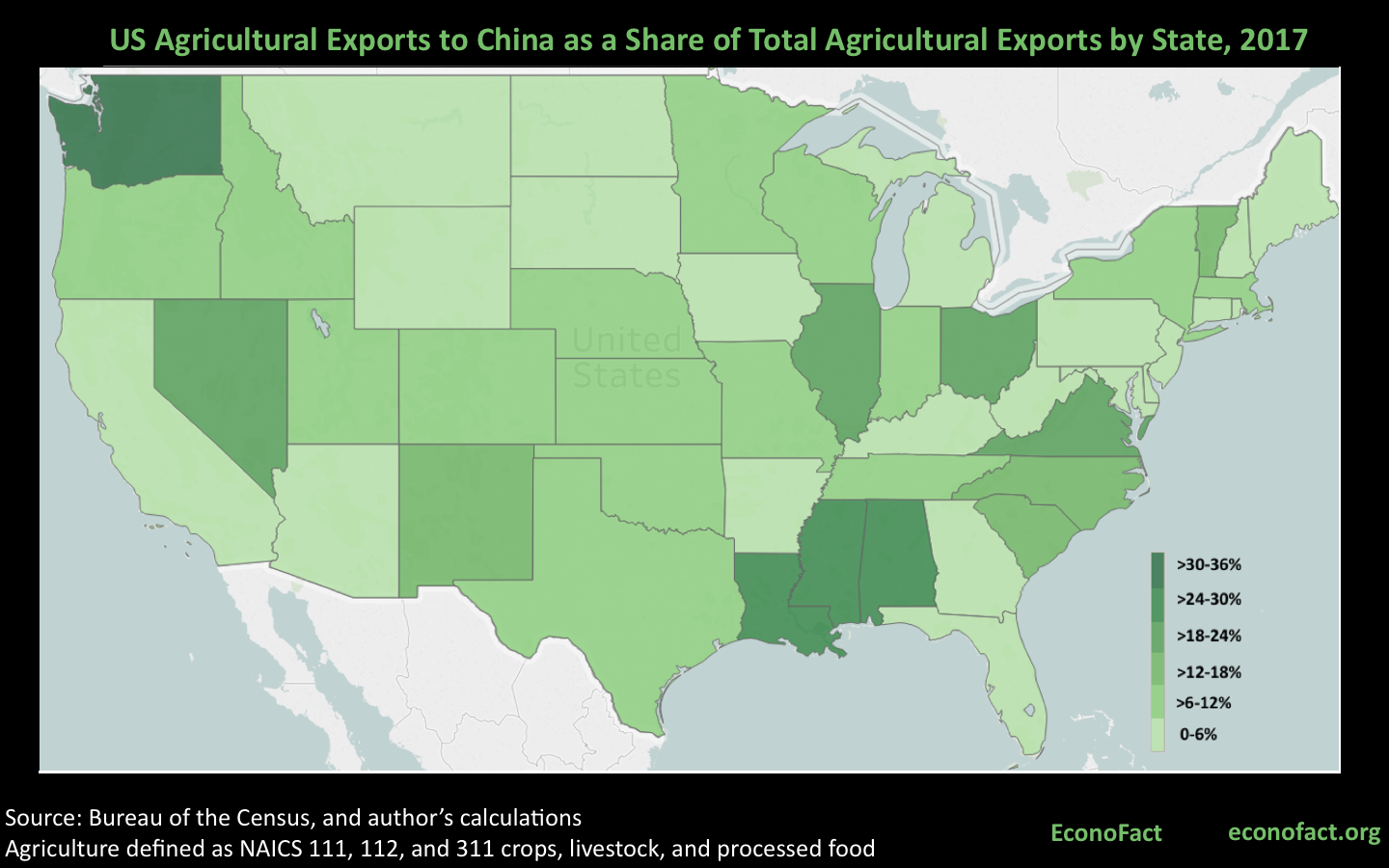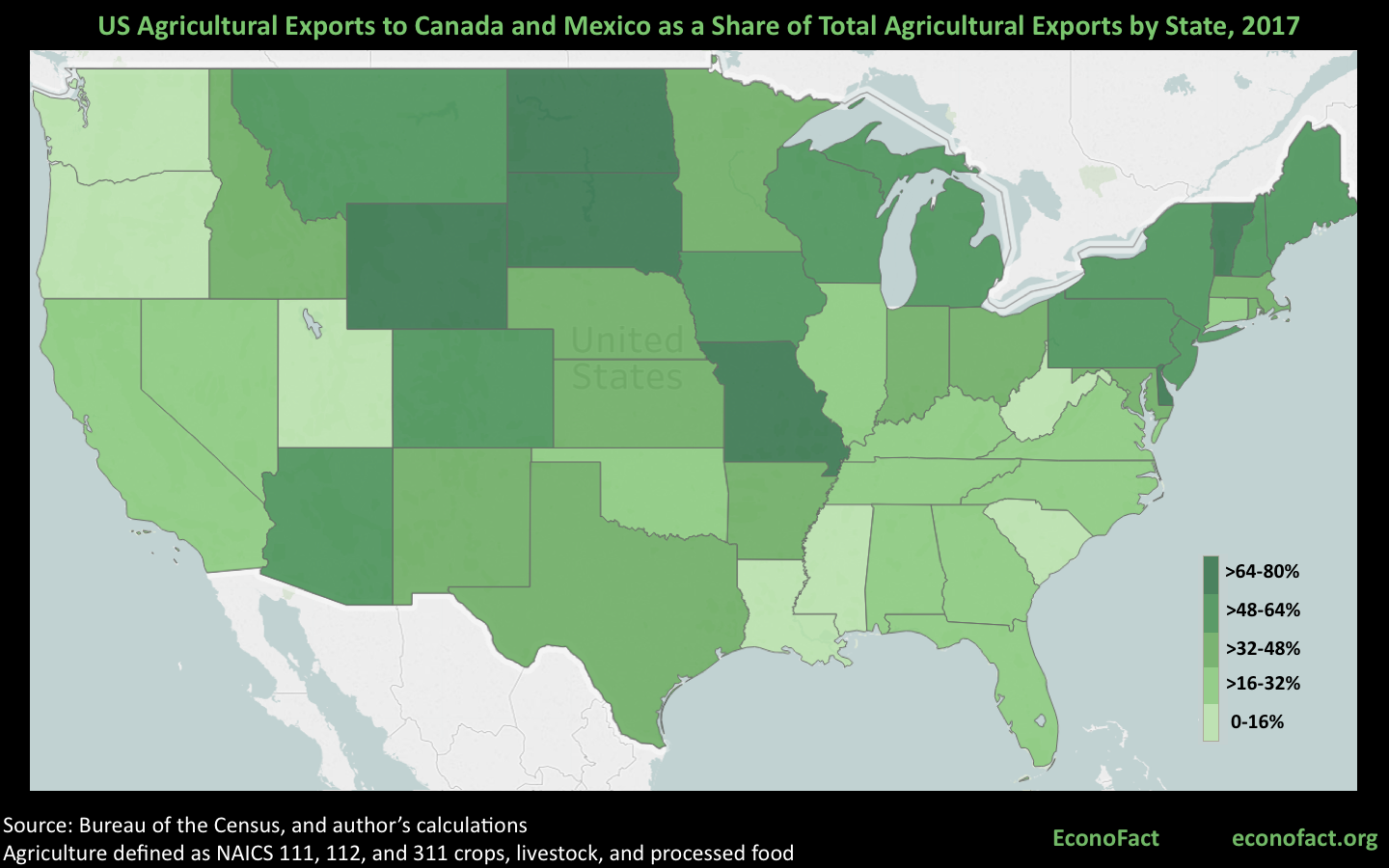Threats to U.S. Agriculture from U.S. Trade Policies (UPDATED)
·August 5, 2018
Robert M. La Follette School, University of Wisconsin-Madison
Robert M. La Follette School, University of Wisconsin-Madison

The Issue:
The agriculture sector in the United States depends upon exports for its vitality. Sales of U.S. agricultural products abroad are responsible for 20 percent of U.S. farm income, supporting more than one million American jobs on and off the farm, according to the U.S. Department of Agriculture. The three biggest buyers of American agricultural products are China, Canada, and Mexico. Yet trade with these three countries faces heightened uncertainty. The Trump Administration is in the process of renegotiating the North American Free Trade Agreement (NAFTA) with Canada and Mexico, which includes the option of exiting the deal altogether. In addition, the United States imposed a number of sanctions on our other trading partners, including China. These sanctions have spurred retaliation that has already harmed some agricultural exports.Retaliatory tariffs from trading partners, especially China, and the potential of withdrawal from NAFTA, threaten U.S. agricultural exports.
The Facts:
- Exports are important to the U.S. agricultural sector and China, Canada, and Mexico are major destinations for U.S. agricultural exports. The United States has traditionally seen itself as the world's breadbasket, habitually running an agricultural trade surplus. The exports of agricultural products (crops, livestock and processed food) from the United States to the rest of the world was $138.4 billion in 2017; $20.5 billion was exported to Canada, $18.6 billion to Mexico, and $19.6 billion to China. In 2017, $12.4 billion alone was accounted for by soybeans exports to China (see here). Agricultural exports of grains and livestock represented almost 41 percent of the $173.4 billion total value added of agriculture in that year. These exports were 4.5 percent of the 2017 value of $1.546 trillion in merchandise exports. Adding in processed food raises the ratio to 8.7 percent. Top U.S. agricultural exports to Mexico include corn, soybean, pork and dairy products. In contrast, prepared food and fresh and processed fruits and vegetables are top agricultural exports to Canada.
- Withdrawal from NAFTA could result in tariffs on United States agricultural exports to Mexico and Canada. Renegotiation of the North American Free Trade Agreement (NAFTA) is underway, with the threat of withdrawal on the table. Under NAFTA, most agricultural products are currently traded duty-free (i.e., zero tariff) among the three NAFTA nations, with a few exempted products (such as dairy, poultry, and eggs for Canada, for instance). Outright withdrawal from NAFTA would cause Mexican and Canadian tariff rates on agricultural commodities to rise, most likely to the levels established under the World Trade Organization (WTO) for most-favored-nation status (MFN). The value of MFN tariffs varies greatly by product. For instance, in the event of NAFTA withdrawal, the maximum MFN tariff that Mexico can apply to corn is 20 percent while the maximum tariff for some meat products can be 75 percent (see here page 8.). If both Canada and Mexico were to exit NAFTA, U.S. agricultural exports to the two countries would become less competitive, as the tariffs would result in higher prices in those markets, and export quantities would decline — potentially between 4.7 and 6.6 percent, depending on the specific circumstances, according to one estimate (see here pg. 32).
- The effects of increased tariffs on agricultural exports from the United States to Canada and Mexico would likely be quite uneven across states. The map depicts the exposure of each state to agricultural trade with Canada and Mexico as a percentage of the states' total agricultural exports (which differs from the pattern of effects of a withdrawal from NAFTA across other sectors of the economy). The Farm Bureau lists Vermont, North Dakota, South Dakota, Delaware and Missouri as the states whose agricultural exports are most at risk from a NAFTA withdrawal.

- Countries have already retaliated against other U.S. moves. The U.S. has implemented aluminum and steel tariffs under the controversial Section 232 (national security concerns). Mexico retaliated by applying tariffs against U.S.-produced hogs and cheese, among other items. Canada has retaliated by applying tariffs primarily against manufactured products, but also against yogurt and tomato products. While China was only slightly affected by the Section 232 tariffs (antidumping tariffs had already drastically reduced Chinese imports of these goods), the Section 301 (intellectual property violations) tariffs imposed directly only on China sparked immediate retaliation, including against soybeans. This single item is perhaps the biggest agricultural target. Consequently, prices for soybeans to be delivered in July plunged from $10.65/bu in early April to $8.80 at mid July -- a 17 percent decline. As is the case with agricultural trade with Mexico and Canada, some U.S. states have greater exposure than others to changes in agricultural exports to China (see top map).
- Many American farmers are already facing reduced prices and lower incomes, relative to earlier in the decade. Prices received by farms for wheat, soybean and corn — which were listed among the top 10 U.S. commodities by cash receipts in 2016 — have fallen by 39, 41 and 53 percent respectively since their peaks in 2012. Largely as a result of lower commodity prices, net farm income decreased dramatically from a record high of $123.8 billion in 2013 to $63.8 billion in 2017, with a slight decrease forecast for 2018 (see here). These already depressed agricultural export prices would experience downward pressure if more trade barriers were erected against U.S. agricultural exports. Since the United States is a net exporter of these commodities, tariff barriers will depress domestic prices as well.
- In response to the damage inflicted on farmers by trade retaliation, the Trump administration announced a package of farm assistance measures. On July 24th, 2018, Secretary of Agriculture Sonny Perdue announced a $12 billion package of assistance to the farm sector. Assistance will come in the form of (1) direct payments to support prices (the Market Facilitation Program), (2) purchases of product to distribute via nutrition programs (Food Purchase and Distribution Program), financed through the Commodity Credit Corporation (CCC), and (3) a trade promotion program to assist farmers in finding new international markets. Because the CCC’s outlays are largely mandatory, and the CCC has up to $30 billion in borrowing authority from the U.S. Treasury, Congressional approval is not necessary for the Administration to make disbursements.
- While the details of the farm aid package are yet to be finalized, the measure raises concerns. It is unclear whether the announced measures will fully offset the effects of tariffs on elevated farm cost and retaliatory tariffs against U.S. agricultural exports. Since this measure is explicitly described as a one-time event, the agricultural sector will not be compensated should the retaliation be of extended duration. Another concern is that the administration’s proposed measure might not be consistent with WTO conventions regarding trade-distorting agricultural measures and hence provide the basis for additional retaliation (or alternatively, additional agricultural supports in our trading partners). Administration officials have indicated the additional outlays on top of the $5 billion current support will remain under the $19.1 billion cap agreed to by the U.S.
What this Means:
Policies implemented and under consideration by the Administration have sparked moves to restrict imports from the United States, putting downward pressure on prices for and quantities of several U.S. agricultural exports. The farm economy is already being affected negatively, with the largest single blow coming from the impact on U.S. soybean prices. Withdrawal from NAFTA would constitute another very heavy blow.
Like what you’re reading? Subscribe to EconoFact Premium for exclusive additional content, and invitations to Q&A’s with leading economists.
Written by The EconoFact Network. To contact with any questions or comments, please email [email protected].
